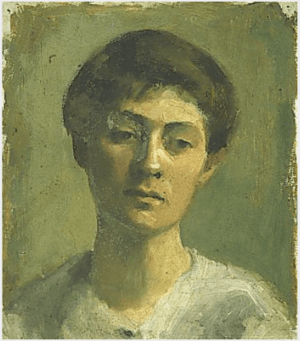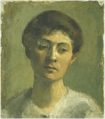Clare Marsh facts for kids
Quick facts for kids
Clare Marsh
|
|
|---|---|
 |
|
| Born | 13 January 1875 Bray, County Wicklow, Ireland
|
| Died | 5 May 1923 (aged 47) |
| Nationality | Irish |
Clare Marsh (born January 13, 1875 – died May 5, 1923) was a talented Irish artist. She was known for painting still life (pictures of objects like fruit or flowers) and portraits (pictures of people).
Contents
Early Life and Family
Clare Marsh was born Emily Cecil Clare Marsh on January 13, 1875. Her birthplace was New Court in Bray, County Wicklow, Ireland. This was the home of her grandfather, Andrew McCullagh. Her parents were Arthur and Rachel Marsh. Clare had four brothers and sisters. Her family had roots in the Anglo-Irish aristocracy. They later moved to Raheen and then Cappaghmore, both in Clondalkin. Not much is known about her early childhood. As an adult, she was involved in the suffrage movement, which worked for women's right to vote.
Becoming an Artist
Clare Marsh met another artist, Mary Swanzy, at art classes taught by May Manning. Swanzy remembered Clare as someone who didn't let money worries stop her, even though she came from a well-off background.
Learning from Others
Clare was greatly inspired by her aunt and by the famous artist John Butler Yeats. She became very close friends with Yeats. In 1898, Yeats painted Clare's portrait in May Manning's studio. Clare preferred the style of the older Yeats over his son, Jack. She based her own portraits on John Butler Yeats's work. He guided her, telling her to see as much art as possible. He also encouraged her to paint more often, saying it would make her think more deeply.
First Exhibitions
Clare first showed her paintings at the Royal Hibernian Academy (RHA) in 1900. Her works were called East wind effect and Roses. John Butler Yeats later said that Clare helped him with his drawing skills.
Art School and Travels
Besides May Manning's classes, Clare also took evening classes in sculpture. She studied with John Hughes and Oliver Sheppard at the Metropolitan School of Art in Dublin.
Clare mostly studied art in Dublin during her twenties. However, she did travel to Paris around 1910 or 1911. She also took a course at Norman Garstin's studio in Penzance, England. In 1914, she stayed in North Wales and painted two scenes of Trearddur Bay.
Popular Paintings
Clare painted many still life works and portraits. One of her portraits was of Lily Yeats, John Butler Yeats's sister. It seems her paintings of children and dogs were very popular. She showed her art at the RHA every year from 1900 to 1921. The Hugh Lane Gallery has her portrait of Lord Ashbourne. This painting shows her style of loose brush strokes, giving it a relaxed feel.
Trip to New York
John Butler Yeats suggested that Clare visit him in the United States. He was living there at the time. Clare spent two months in New York. She first stayed with cousins in White Plains. Then she moved into a room next to Yeats's place. Her uncle strongly disagreed with this living arrangement. So, she left and returned to Ireland in January 1912. This made Yeats very sad.
Later Career
After returning from New York, Clare Marsh started teaching art classes. Her studio was on South Anne Street. Mary Swanzy remembered that Clare's classes were "well liked and always full." Even Mrs. Susan Yeats became one of her students. In 1916, Clare became a Professor of Fine Arts at Alexandra College.
Painting History
In the same year, 1916, Clare painted the fires and destruction from the Easter Rising. This was a major event in Irish history. In 1918, she painted a portrait of Jack Butler Yeats. This painting is now kept at the Highlanes Gallery. John Butler Yeats later felt it was unfair that Clare and other women artists were not chosen as members of the RHA.
Clare also helped Yeats when he was having money problems. She sold some of his drawings and sent him the money. Over time, Clare started using more color in her paintings. Her portrait of Mrs. Susan Yeats shows this change. Her last paintings were studies of night scenes. Some of these might show the influence of Mary Swanzy, with whom she shared a studio in late 1920. Clare is also thought to have been one of the artists who started the Society of Dublin Painters.
Death and Legacy
Clare Marsh passed away on May 5, 1923. An exhibition of her artwork was held after her death in October 1923. Because she died young, Clare Marsh was largely forgotten for a while. However, one of her paintings was included in a 1987 exhibition. This show, called "Irish Women Artists from the Eighteenth Century to the Present Day," was held at the National Gallery of Ireland. The National Gallery of Ireland now has some of Clare's sketches and paintings. They also have a sketch of her by Mary Swanzy. Clare's work was also part of an exhibition of art by women artists at the Highlanes Gallery in 2012.
Images for kids


